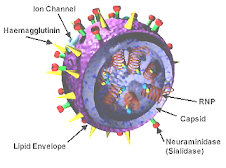| 16:54 UK time, Tuesday, 24 November 2009
It's been one of the big questions of this pandemic. Just how many of us in Britain have actually had swine flu?
Knowing that would be incredibly useful, as the bigger the proportion infected, the further we are into this pandemic and the less likely there will be a further sting in its tail.
The Health Protection Agency (HPA) has done blood tests of hundreds of children and parents connected to early school outbreaks.
The Health Protection Agency (HPA) has done blood tests of hundreds of children and parents connected to early school outbreaks.
With one school in south west England they tested around 500 people. They found that although around one in 10 children fell ill, three to five times as many got infected and developed antibodies.
After analysing this and other data relating to the number of children being seen by GPs, the HPA has now come up with these interesting estimates:
• Up to one third of children in swine flu hotspots (such as England and the West Midlands) have already been infected with the H1N1 virus.
• Across the UK up to one in five children has had had swine flu.
• About half of those who get infected show no symptoms.
This is all very reassuring. Professor Maria Zambon from the HPA said:
• Up to one third of children in swine flu hotspots (such as England and the West Midlands) have already been infected with the H1N1 virus.
• Across the UK up to one in five children has had had swine flu.
• About half of those who get infected show no symptoms.
This is all very reassuring. Professor Maria Zambon from the HPA said:
"We didn't get the pandemic that we planned for and you might say that we've been lobbed a soft ball. There hasn't been high case mortality, the virus is sensitive to drugs, and we've been able to make vaccine and roll it out. I am incredibly grateful that we are not dealing with a pandemic of H5 (bird flu)."
Professor Zambon said the virus had had a relatively low impact on older adults and that was probably explained by pre-existing immunity. The HPA has these estimates:
• For those aged over 50 up to four in 10 people have pre-existing protective antibodies to the H1N1 pandemic virus.
• If you are under 50 it falls to around one in 10 of the population.
The professor, who is an acknowledged world expert on flu, did utter a few words of caution. "Influenza is full of mystery and intrigue. It has lots of twists and turns" and she predicted that mutations of the swine flu virus should be expected. She also pointed out that there could still be a substantial outbreak of seasonal flu over winter.
• For those aged over 50 up to four in 10 people have pre-existing protective antibodies to the H1N1 pandemic virus.
• If you are under 50 it falls to around one in 10 of the population.
The professor, who is an acknowledged world expert on flu, did utter a few words of caution. "Influenza is full of mystery and intrigue. It has lots of twists and turns" and she predicted that mutations of the swine flu virus should be expected. She also pointed out that there could still be a substantial outbreak of seasonal flu over winter.



